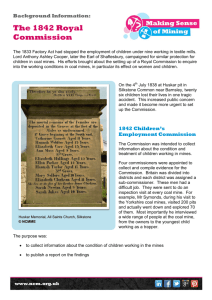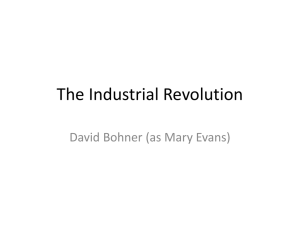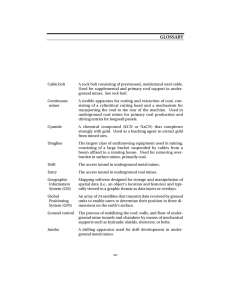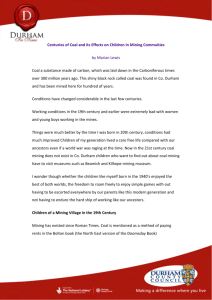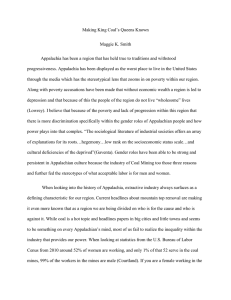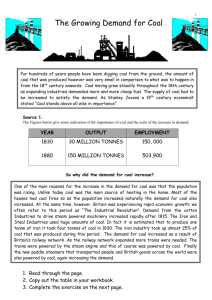FF12 - Women and Children pre-1842
advertisement
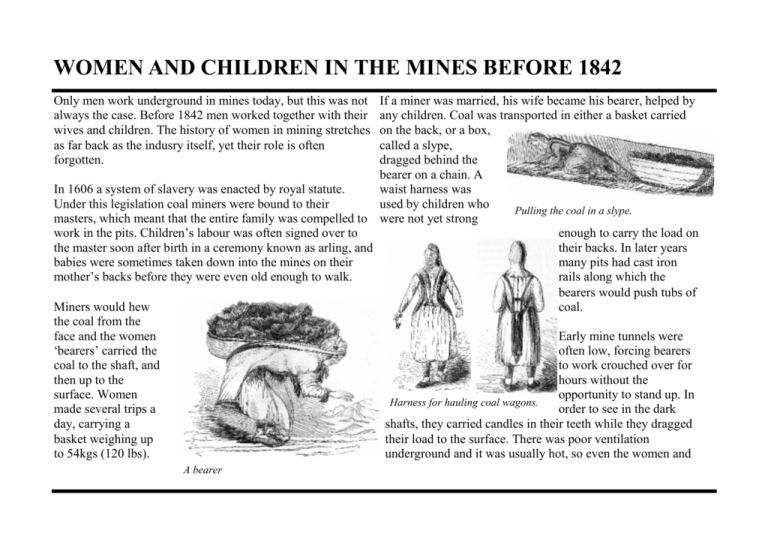
WOMEN AND CHILDREN IN THE MINES BEFORE 1842 Only men work underground in mines today, but this was not always the case. Before 1842 men worked together with their wives and children. The history of women in mining stretches as far back as the indusry itself, yet their role is often forgotten. If a miner was married, his wife became his bearer, helped by any children. Coal was transported in either a basket carried on the back, or a box, called a slype, dragged behind the bearer on a chain. A In 1606 a system of slavery was enacted by royal statute. waist harness was Under this legislation coal miners were bound to their used by children who Pulling the coal in a slype. masters, which meant that the entire family was compelled to were not yet strong work in the pits. Children’s labour was often signed over to enough to carry the load on the master soon after birth in a ceremony known as arling, and their backs. In later years babies were sometimes taken down into the mines on their many pits had cast iron mother’s backs before they were even old enough to walk. rails along which the bearers would push tubs of Miners would hew coal. the coal from the face and the women Early mine tunnels were ‘bearers’ carried the often low, forcing bearers coal to the shaft, and to work crouched over for then up to the hours without the surface. Women opportunity to stand up. In Harness for hauling coal wagons. made several trips a order to see in the dark day, carrying a shafts, they carried candles in their teeth while they dragged basket weighing up their load to the surface. There was poor ventilation to 54kgs (120 lbs). underground and it was usually hot, so even the women and A bearer WOMEN AND CHILDREN IN THE MINES BEFORE 1842 girls often worked naked to the waist. Flooding was a constant problem. Water seeped into the newly dug roadways, resulting in bearers working bare-foot in pools of water. These horrific working conditions left many people in mining communities with stunted bodies and swollen legs. In mining families parents usually worked together in the mines and children most often accompanied them. Children aged as young as five were assigned to be ‘trappers’, opening and shutting underground doors Young girls also worked as bearers. for ventilation. In mines with low seams and roadways children could maneouvre more easily and therefore often worked as bearers in preference to women. Even very young children were typically expected to work a twelve hour day. In 1799 the system of slavery was banned, but economic bondage still continued for women underground. Men were paid extremely low wages and women earned even less. Miners had to pay their bearers out of their own wages and this was an incentive for men to marry. Without a wife to carry the coal, a miner would have to pay a young girl to work for him. In contrast, a wife working as a bearer did not have to be paid as her labour contributed to the family’s income. This system of work came to an end in 1842 when the Mines Act banned women, and children under the age of ten from working underground. Women from mining families continued to work, but did so on the surface as pickers, sorting the coal.
